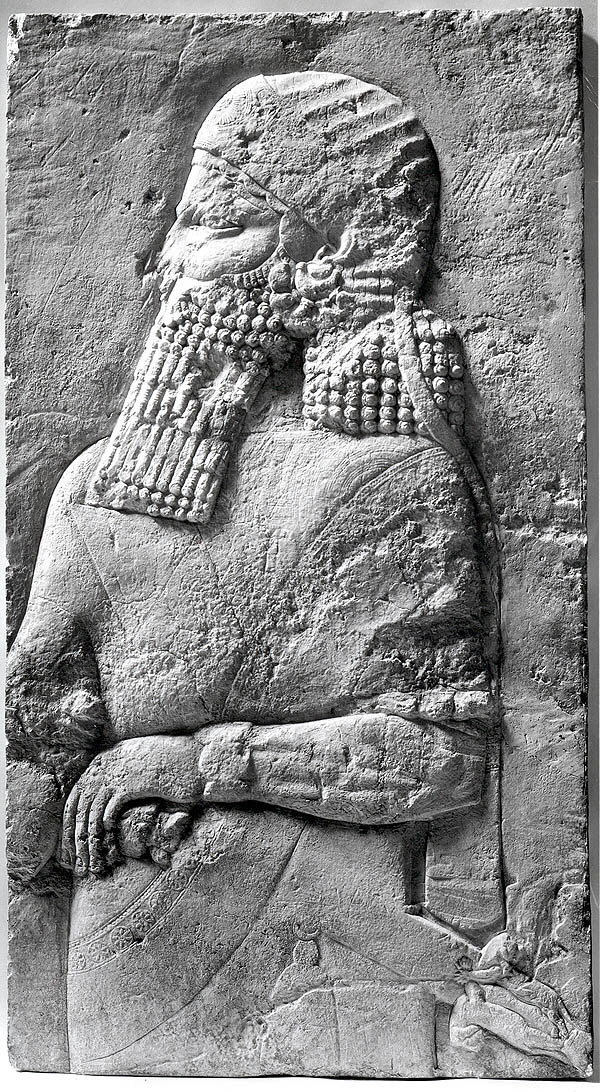|
Naqiʾa
Naqiʾa or Naqia (Akkadian language, Akkadian: , also known as Zakūtu (), was a wife of the Assyrian king Sennacherib (705–681 BC) and the mother of his son and successor Esarhaddon (681–669). Naqiʾa is the best documented woman in the history of the Neo-Assyrian Empire and she reached an unprecedented level of prominence and public visibility; she was perhaps the most influential woman in Assyrian history. She is one of the few ancient Assyrian women to be depicted in artwork, to commission her own building projects, and to be granted laudatory epithets in letters by courtiers. She is also the only known ancient Assyrian figure other than kings to write and issue a treaty. Naqiʾa must have been married to Sennacherib before he became king (705) since she gave birth to his son Esarhaddon 713. Whether she ever held the position of Queens of the Neo-Assyrian Empire, queen is debated; Assyrian kings had multiple wives but the evidence suggests that only one of them coul ... [...More Info...] [...Related Items...] OR: [Wikipedia] [Google] [Baidu] |
Esarhaddon
Esarhaddon, also spelled Essarhaddon, Assarhaddon and Ashurhaddon (, also , meaning " Ashur has given me a brother"; Biblical Hebrew: ''ʾĒsar-Ḥaddōn'') was the king of the Neo-Assyrian Empire from 681 to 669 BC. The third king of the Sargonid dynasty, Esarhaddon is most famous for his conquest of Egypt in 671 BC, which made his empire the largest the world had ever seen, and for his reconstruction of Babylon, which had been destroyed by his father. After Sennacherib's eldest son and heir Aššur-nādin-šumi had been captured and presumably executed in 694, the new heir had originally been the second eldest son, Arda-Mulissu, but in 684, Esarhaddon, a younger son, was appointed instead. Angered by this decision, Arda-Mulissu and another brother, Nabû-šarru-uṣur, murdered their father in 681 and planned to seize the Neo-Assyrian throne. The murder, and Arda-Mulissu's aspirations of becoming king himself, made Esarhaddon's rise to the throne difficult and he first ... [...More Info...] [...Related Items...] OR: [Wikipedia] [Google] [Baidu] |
Ešarra-ḫammat
Ešarra-ḫammat (, meaning "Ešarra is mistress") was a queen of the Neo-Assyrian Empire as the primary consort of Esarhaddon (681–669 BC). Ešarra-ḫammat had been married to Esarhaddon for over a decade by the time he became king, having married him 695 BC. Few sources from Ešarra-ḫammat's lifetime that mention her are known and she is thus chiefly known from sources dating to after her death in February 672 BC, an event which deeply affected Esarhaddon. Esarhaddon had a great mausoleum constructed for her, unusual for burials of Assyrian queens, and had her death recorded in the Babylonian Chronicles. Ešarra-ḫammat might have been the mother of Esarhaddon's most prominent children, i.e. the daughter Šērūʾa-ēṭirat and the sons Ashurbanipal and Shamash-shum-ukin. Life Ešarra-ḫammat married Esarhaddon 695 BC. According to the Austrian British Assyriologist Gwendolyn Leick, Ešarra-ḫammat might have been of Babylonian ancestry. Ešarra-ḫammat is known ... [...More Info...] [...Related Items...] OR: [Wikipedia] [Google] [Baidu] |
Queens Of The Neo-Assyrian Empire
The queen ( Assyrian: ''issi ekalli'' or ''sēgallu'', ) of the Neo-Assyrian Empire was the consort of the Neo-Assyrian king. Though the queens derived their power and influence through their association with their husband, they were not pawns without political power. The queens oversaw their own, often considerable, finances and owned vast estates throughout the empire. To oversee their assets, the queens employed a large administrative staff headed by a set of female administrators called ''šakintu''. Among the duties of the queens were religious responsibilities and overseeing parts of the royal palaces; their role as "rulers of the domestic realm" is reflected in their title as "Women of the Palace". The power and influence of the queens was increased further under the Sargonid dynasty (722–609 BC), when they more frequently appear in artwork and large military units directly subservient to the queen were created. The most famous and powerful Neo-Assyrian queen was Sham ... [...More Info...] [...Related Items...] OR: [Wikipedia] [Google] [Baidu] |
Relief Esarhaddon Louvre AO20185
Relief is a sculptural method in which the sculpted pieces remain attached to a solid background of the same material. The term ''relief'' is from the Latin verb , to raise (). To create a sculpture in relief is to give the impression that the sculpted material has been raised above the background plane. When a relief is carved into a flat surface of stone (relief sculpture) or wood (relief carving), the field is actually lowered, leaving the unsculpted areas seeming higher. The approach requires chiselling away of the background, which can be time-intensive. On the other hand, a relief saves forming the rear of a subject, and is less fragile and more securely fixed than a sculpture in the round, especially one of a standing figure where the ankles are a potential weak point, particularly in stone. In other materials such as metal, clay, plaster stucco, ceramics or papier-mâché the form can be simply added to or raised up from the background. Monumental bronze reliefs are ma ... [...More Info...] [...Related Items...] OR: [Wikipedia] [Google] [Baidu] |
Erbil
Erbil (, ; , ), also called Hawler (, ), is the capital and most populated city in the Kurdistan Region of Iraq. The city is the capital of the Erbil Governorate. Human settlement at Erbil may be dated back to the 5th millennium BC. At the heart of the city is the ancient Citadel of Erbil and Mudhafaria Minaret. The earliest historical reference to the region dates to the Third Dynasty of Ur of Sumer, when King Shulgi mentioned the city of Urbilum. The city was later conquered by the Assyrian people, Assyrians. In the 3rd millennium BC, Erbil was an independent power in its area. It was conquered for a time by the Gutians. Beginning in the late 2nd millennium BC, it came under Assyrian control. Subsequent to this, it was part of the geopolitical province of Assyria under several empires in turn, including the Median Empire, the Achaemenid Empire (Achaemenid Assyria), Macedonian Empire, Seleucid Empire, Kingdom of Armenia (antiquity), Armenian Empire, Parthian Empire, Assyria ... [...More Info...] [...Related Items...] OR: [Wikipedia] [Google] [Baidu] |
Astrology
Astrology is a range of Divination, divinatory practices, recognized as pseudoscientific since the 18th century, that propose that information about human affairs and terrestrial events may be discerned by studying the apparent positions of Celestial objects in astrology, celestial objects. Different cultures have employed forms of astrology since at least the 2nd millennium BCE, these practices having originated in Calendrical calculation, calendrical systems used to predict seasonal shifts and to interpret celestial cycles as signs of divine communications. Most, if not all, cultures have attached importance to what they observed in the sky, and some—such as the Hindu astrology, Hindus, Chinese astrology, Chinese, and the Maya civilization, Maya—developed elaborate systems for predicting terrestrial events from celestial observations. Western astrology, one of the oldest astrological systems still in use, can trace its roots to 19th–17th century BCE Mesopotamia, fr ... [...More Info...] [...Related Items...] OR: [Wikipedia] [Google] [Baidu] |
Divination
Divination () is the attempt to gain insight into a question or situation by way of an occultic ritual or practice. Using various methods throughout history, diviners ascertain their interpretations of how a should proceed by reading signs, events, or omens, or through alleged contact or interaction with supernatural agencies such as ghost, spirits, gods, god-like-beings or the "will of the universe". Divination can be seen as an attempt to organize what appears to be random so that it provides insight into a problem or issue at hand. Some instruments or practices of divination include Tarot card reading, Tarot-card reading, Runic magic, rune casting, Tasseography, tea-leaf reading, automatic writing, water scrying, and psychedelics like psilocybin mushrooms and DMT. If a distinction is made between divination and fortune-telling, divination has a more formal or ritualistic element and often contains a more social character, usually in a religion, religious context, as se ... [...More Info...] [...Related Items...] OR: [Wikipedia] [Google] [Baidu] |
Arda-Mulissu
Arda-Mulissu or Arda-Mulissi (, ), also known as Urdu-Mullissi, Urad-Mullissu and Arad-Ninlil and known in Hebrew writings as Adrammelech ( ''ʾAḏrammeleḵ''), was an ancient Assyrian prince of the Sargonid dynasty, the son of Sennacherib, king of the Neo-Assyrian Empire, and the older brother of Sennacherib's successor Esarhaddon. Arda-Mulissu served as Sennacherib's crown prince and heir for ten years, from the time of the death of Sennacherib's first crown prince Ashur-nadin-shumi in 694 BC, but was for unknown reasons replaced as heir by Esarhaddon in 684 BC. Disappointed by this demotion, Arda-Mulissu was the chief orchestrator of a 681 BC conspiracy in which he and one of his younger brothers, Nabu-shar-usur, murdered Sennacherib in the hopes of seizing the throne. Sennacherib's murder turned some of Arda-Mulissu's supporters against him and his coronation was postponed. In the turmoil that followed, Esarhaddon marched on the Assyrian capital of Nineveh and successfully ... [...More Info...] [...Related Items...] OR: [Wikipedia] [Google] [Baidu] |
Sargon II
Sargon II (, meaning "the faithful king" or "the legitimate king") was the king of the Neo-Assyrian Empire from 722 BC to his death in battle in 705. Probably the son of Tiglath-Pileser III (745–727), Sargon is generally believed to have become king after overthrowing Shalmaneser V (727–722), probably his brother. He is typically considered the founder of a new dynastic line, the Sargonid dynasty. Modelling his reign on the legends of the ancient rulers Sargon of Akkad, from whom Sargon II likely took his regnal name, and Gilgamesh, Sargon aspired to conquer the known world, initiate a golden age and a new world order, and be remembered and revered by future generations. Over the course of his seventeen-year reign, Sargon substantially expanded Assyrian territory and enacted important political and military reforms. An accomplished warrior-king and military strategist, Sargon personally led his troops into battle. By the end of his reign, all of his major enemies and r ... [...More Info...] [...Related Items...] OR: [Wikipedia] [Google] [Baidu] |
Crown Prince
A crown prince or hereditary prince is the heir apparent to the throne in a royal or imperial monarchy. The female form of the title, crown princess, is held by a woman who is heir apparent or is married to the heir apparent. ''Crown prince'' as a descriptive term has been used throughout history for the prince who is first-in-line to a throne and is expected to succeed (i.e. the heir apparent), barring any unforeseen future event preventing this. In certain monarchies, a more specific substantive title may be accorded and become associated with the position of heir apparent (e.g. Prince of Wales in the United Kingdom, Prince of Asturias in the Spain, Kingdom of Spain and formerly the Dauphin of France, Dauphin in Kingdom of France, France). In these monarchies, the term crown prince may be used less often than the substantive title (or never). Until the late twentieth century, no modern monarchy adopted a system whereby females would be guaranteed to succeed to the throne ... [...More Info...] [...Related Items...] OR: [Wikipedia] [Google] [Baidu] |
Aramaic
Aramaic (; ) is a Northwest Semitic language that originated in the ancient region of Syria and quickly spread to Mesopotamia, the southern Levant, Sinai, southeastern Anatolia, and Eastern Arabia, where it has been continually written and spoken in different varieties for over three thousand years. Aramaic served as a language of public life and administration of ancient kingdoms and empires, particularly the Neo-Assyrian Empire, Neo-Babylonian Empire, and Achaemenid Empire, and also as a language of divine worship and religious study within Judaism, Christianity, and Gnosticism. Several modern varieties of Aramaic are still spoken. The modern eastern branch is spoken by Assyrians, Mandeans, and Mizrahi Jews.{{cite book , last1=Huehnergard , first1=John , author-link1=John Huehnergard , last2=Rubin , first2=Aaron D. , author-link2=Aaron D. Rubin , date=2011 , editor-last=Weninger , editor-first=Stefan , title=The Semitic Languages: An International Handbook , pub ... [...More Info...] [...Related Items...] OR: [Wikipedia] [Google] [Baidu] |








